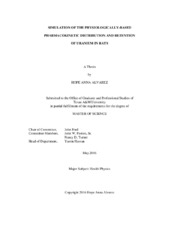| dc.contributor.advisor | Ford, John | |
| dc.creator | Alvarez, Hope Anna | |
| dc.date.accessioned | 2016-07-08T15:08:36Z | |
| dc.date.available | 2016-07-08T15:08:36Z | |
| dc.date.created | 2016-05 | |
| dc.date.issued | 2016-02-09 | |
| dc.date.submitted | May 2016 | |
| dc.identifier.uri | https://hdl.handle.net/1969.1/156863 | |
| dc.description.abstract | The objective of this research project was to create a computer simulation in SIMULINK® to model the distribution and retention of uranium in rats using a compilation of published experimental data that has been acquired over the years by different research groups. This program was created using a general acute baseline model with predefined parameters to account for uranium distribution in rats. The computer simulation response to an ingestion of exogenous uranium material within a rat and the growth in organ size with respect to the age of rat was composed in SIMULINK®.
The results of the baseline model simulation were benchmarked against a research experiment that examined distribution and retention of uranium in rats. The simulation program was tested using various input methods to evaluate the change in program response. The simulation program and implemented methodology indicates that the SIMULINK® program is a user friendly program that allows researchers to customize compartmental functions. Simulation results indicate that a biological experiment that lacks a patterned response is difficult to model in a simulation program with predefined parameters. Using the original baseline acute model simulation results for uranium, the predefined parameters were tested in this research and indicate that a modification to the predefined parameters is essential to properly model biological responses.
A reformulation of compartmental biological parameters such as the removal half-time and/or deposition fraction into various compartments is proposed based on the simulation results. This change to predefined parameters is not excluded by the published data. The simulation results also indicate specific sections of organ response that require additional investigation for effective models. As more research data becomes available, the program can be modified to improve upon this simulation model. | en |
| dc.format.mimetype | application/pdf | |
| dc.language.iso | en | |
| dc.subject | computer simulation in SIMULINK | en |
| dc.subject | model the distribution and retention of uranium | en |
| dc.subject | computer simulation response to an ingestion of exogenous uranium material within a rat | en |
| dc.title | Simulation of the Physiologically-Based Pharmacokinetic Distribution and Retention of Uranium in Rats | en |
| dc.type | Thesis | en |
| thesis.degree.department | Nuclear Engineering | en |
| thesis.degree.discipline | Health Physics | en |
| thesis.degree.grantor | Texas A & M University | en |
| thesis.degree.name | Master of Science | en |
| thesis.degree.level | Masters | en |
| dc.contributor.committeeMember | Poston, John W | |
| dc.contributor.committeeMember | Turner, Nancy D | |
| dc.type.material | text | en |
| dc.date.updated | 2016-07-08T15:08:36Z | |
| local.etdauthor.orcid | 0000-0003-1964-2110 | |


